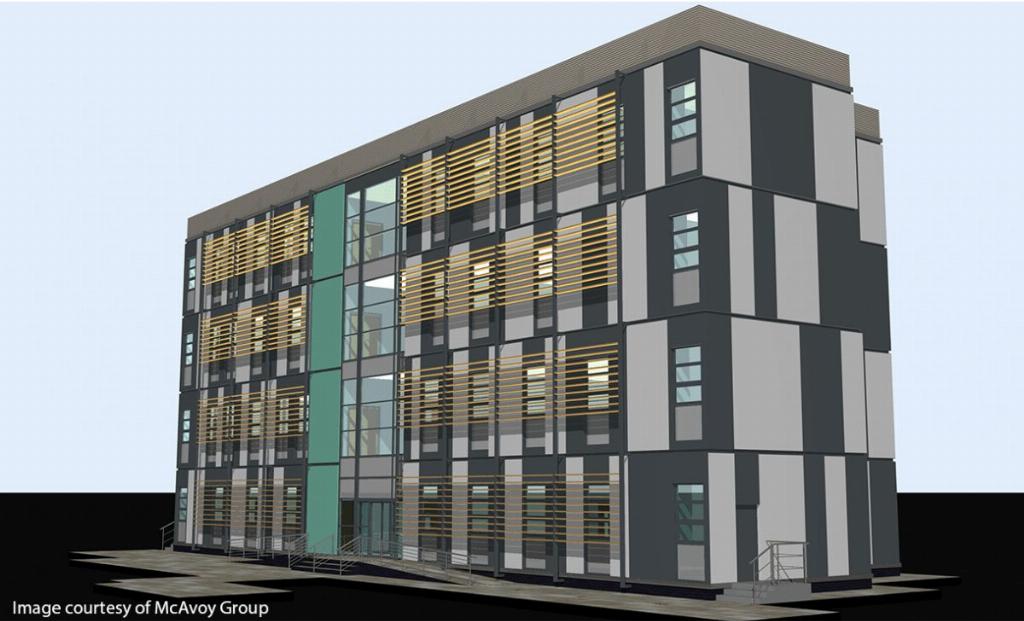Building a future together

Composites in Manufacturing hears from the National Composites Centre on its partnership with Network Rail to build a composite footbridge and its involvement in a consortium-led project looking at the future of construction.
The National Composites Centre (NCC) has partnered with Network Rail to investigate, design and build a composite footbridge. The partnership sees Network Rail join the NCC as a Tier One Member - the first rail infrastructure company to do so - which gives Network Rail access to use the world-leading expertise facilities and capabilities at the Centre.
The concept footbridge, conceived and designed by Marks Barfield Architects & COWI and called ‘Futura’, is being developed into a prototype to demonstrate the benefits that can be gained from using composites in railway station environments for both new build and replacement structures.
“We’re delighted to be working on this ground-breaking project with Network Rail, and that they have joined us as a member. There is clear alignment between the long-term strategic goals of the two organisations - namely to accelerate the adoption of composites in construction and to support the UK’s supply chain development to achieve the Government’s Construction 2025 strategy,” said Richard Oldfield, chief executive of the NCC.
“Composites offer huge benefits to construction, not least in their ability to be built using modern methods, as well as the cost-effective nature of their construction and installation. They are a more sustainable solution, which will contribute to net-zero targets across the industry, and are an intrinsically safer and more aesthetically pleasing option.”
Ian Grimes, principal engineer from Network Rail added: “Our main focus is on putting our passengers first and exploring the full potential of composites as an alternative low carbon construction material will enable us to continue doing this.
“The quicker installation and the corrosion resistant nature of composites will mean less disruption and impact on passengers when we’re installing and maintaining our assets. This offers further environmental benefits alongside cost savings which can then be reinvested into other parts of the network.”
The footbridge demonstrator will adopt modern methods of construction and platform architecture through a standardised design and set of adaptable components created in factories with digital controls for simple, rapid precision fit assembly in the station environment. It will also enable innovation that can be transferred to the wider transport infrastructure and nurture the supply-chain, so it is “not held back by historical norms” as identified in the Transport Infrastructure Efficiency strategy set out by the Government. The project will specifically target key metrics of reduced cost and reduced greenhouse gas emissions in line with Construction 2025.

“High strength modern composite materials present huge opportunities for a new generation of bridges and structures,” commented Ian Firth, engineering designer with COWI, “and we are delighted to be working with Marks Barfield, NCC and Network Rail to bring this elegant design to life on the railways. This is a material we have used before in bridge design, but I am particularly excited about the opportunity to optimise its use on this project to achieve the very best performance advantages that the material allows.”
Ian Crockford, project director at Marks Barfield Architects, added: “After two years in the making MBA are delighted to be kicking off this exciting project with COWI and the team at the NCC for Network Rail. Our aim from the inception of the project has been to bring the benefits of large-scale pre-fabrication using cutting edge innovation through the use of composite materials, whilst at the same time delivering on Peter Hendy’s aim of delivering high quality design to the rail sector.”
Seismic innovations
Meanwhile, a £6m project to transform the way schools and healthcare facilities are built has been granted £2.9m of funding to showcase the future of modern methods of construction (MMC) in the UK.
The NCC is part of the consortium-led Seismic II project, which is working on the future of construction. Among a range of outcomes, the UK Research and Innovation (UKRI) funded project via the Industrial Strategy Challenge Fund will create a set of standardised reconfigurable components, working closely with the Construction Innovation Hub to align platform interface standards. These components will reduce waste, cost and carbon dioxide emissions while increasing speed of delivery.
Graeme Jeremy, head of construction and infrastructure at the NCC, said: “Fibre Polymer Composite (FPC) materials offer a huge range of benefits to the construction industry. Their strength and durability not only give advantages to the build itself, but can also improve the sustainability of the building, reducing its carbon footprint and whole life costs.
“Using advanced materials in construction is still relatively novel, and through the Seismic II project, we’ll be investigating areas where composites can add the most value to modular buildings, taking advantage of the increasing uptake in manufacturing.”
The consortium is conscious of the need to align and harmonise its work with the outputs of the Construction Innovation Hub and will be working with them throughout to ensure maximum impact.
Government procurement is already set to shift from traditional construction methods to MMC. Seismic II will show how this shift can happen while meeting the government’s own ‘Construction 2025’ vision of lower costs and emissions, faster delivery and an increase in exports from the industry.
Currently, most traditional UK construction relies on bespoke systems created by individual manufacturers. A lack of standardisation means different systems are incompatible, causing errors, delays and defects.
Seismic II builds on the success of the Seismic I project, which showed how a standardised light steel frame could change the way new schools were designed and constructed. With the new award from the Industrial Strategy Challenge Fund, the system will encompass the production of wall, floor, ceiling and roof components that are all completely interoperable with the standardised light steel frame.
The automotive industry has long been the standard bearer for streamlined production and component assembly. The aim of Seismic II is to show that similar principles can be applied to the construction industry.

Along with improving the offsite production processes for projects using MMC, Seismic II will also look at the whole life performance of the buildings produced this way. The government’s industrial strategy aims to reduce the construction costs and whole life costs of buildings by a third, while seeing those same buildings delivered in half the time and with a 50% reduction in carbon emissions from the sector.
Adopting MMC is essential to meet those targets and Seismic II is well-positioned to deliver on them. Centred around a digital approach to design, production and operation, the platform will use linked data from start to finish. This approach ensures that the building delivered on site matches the design intent, performs as expected, and can be managed efficiently throughout its life.
Originally intended for school construction, Seismic II has drawn interest from the healthcare, commercial and residential sectors. The completed demonstrator building will be a template for high performance buildings of all types, delivered using high quality, reliable, standardised components.









